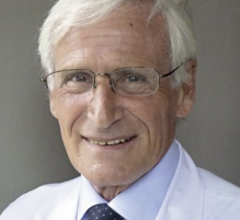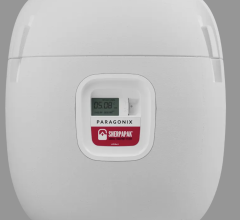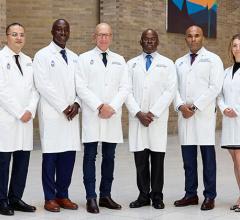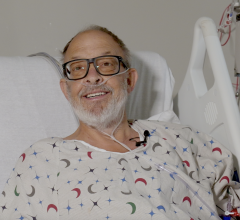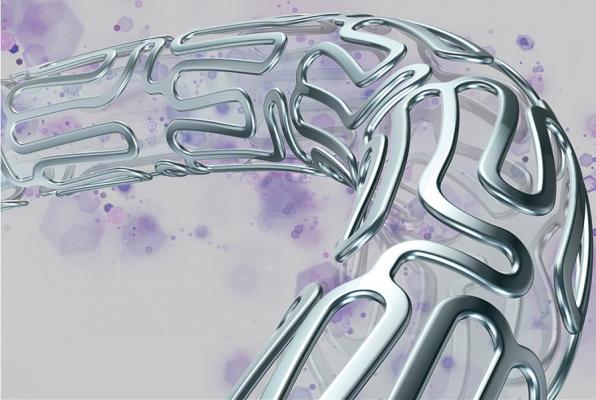
October 31, 2016 — A major international study has found that drug-eluting stents, a less-invasive alternative to bypass surgery, is as effective as surgery for many patients with a blockage in the left main coronary artery.
Findings from the EXCEL (Evaluation of Xience versus Coronary Artery Bypass Surgery for Effectiveness of Left Main Revascularization) trial were published this morning online in the New England Journal of Medicine and presented at the annual Transcatheter Cardiovascular Therapeutics conference in Washington, D.C. The trial research team included interventional cardiologists and cardiac surgeons from 126 centers in 17 countries.
Coronary artery bypass graft (CABG) surgery has long been considered the definitive treatment for patients with left main coronary artery disease (LMCAD), in which the artery that supplies oxygen-rich blood to most of the heart muscle is clogged with atherosclerotic plaque. About two-thirds of all LMCAD patients have mild to moderate disease in the remainder of the coronary arteries.
“Our study has shown that many patients with left main coronary artery disease who prefer a minimally invasive approach can now rest assured that a stent is as effective as bypass surgery for at least three years, and is initially safer, with fewer complications from the procedure,” said first author Gregg W. Stone, M.D., professor of medicine at Columbia University Medical Center and director of cardiovascular research and education at the Center for Interventional Vascular Therapy at NewYork-Presbyterian/Columbia.
Stents, which are placed into the diseased artery via a catheter that is inserted through a small opening in a blood vessel in the groin, arm or neck, are a less-invasive treatment option for many people with coronary artery disease. However, CABG has long been considered the definitive treatment for patients with LMCAD, which affects a large portion of the heart muscle.
Watch a VIDEO discussion with David Kandzari, M.D., director of interventional cardiology and chief scientific officer, Piedmont Heart Institute, Atlanta, Ga.. Kandzari explains the impact of the EXCEL Trial at TCT 2015. Piedmont recruited the highest number of patients for the large, randomized trial
Previously, randomized clinical trials suggested that first-generation drug-eluting stents, which release antiproliferative medications to prevent the artery from becoming re-occluded after stent placement, might be appropriate for patients with LMCAD without extensive blockages in the remainder of the heart arteries. The trial results, however, were inconclusive. “Since that time, stents have gotten better, and so has cardiac bypass surgery,” said Stone. “That required us to take a fresh look at the relative safety and effectiveness of the two approaches.”
Between September 2010 and March 2014, 2,905 patients with LMCAD were recruited at 126 sites in 17 countries, including 1,905 randomized and 1,000 registry patients. Eligible patients (n=1,905) with LMCAD and low or intermediate coronary artery disease complexity (SYNTAX score ≤32) were randomized to revascularization with fluoropolymer-based cobalt-chromium everolimus-eluting stents (EES; n=948) or CABG (n=957). The primary endpoint was the three-year composite rate of death, stroke or myocardial infarction (MI), powered for noninferiority testing. Major secondary outcomes included this endpoint at 30 days, and the composite rate of death, stroke, MI or ischemia-driven revascularization at three years.
At three years, the primary endpoint of death, stroke or MI occurred in 15.4 percent of EES patients and 14.7 percent of CABG patients (difference [upper 97.5% confidence limit] = 0.7% [4.0%], Pnoninferiority=0.018; HR [95%CI] = 1.00 [0.79, 1.26], Psuperiority=0.98). The secondary endpoint of death, stroke or MI at 30 days occurred in 4.9 percent EES patients and 7.9 percent CABG patients (Psuperiority=0.008). Death, stroke, MI or ischemia-driven revascularization at three years occurred in 23.1 percent EES patients and 19.1 percent CABG patients (Pnoninferiority=0.01; Psuperiority=0.10). Patients treated with percutaneous coronary intervention (PCI) rather than CABG had fewer MIs, and less bleeding, infections, arrhythmias and renal failure within 30 days, although more repeat revascularization procedures at three years. Fewer patients developed definite stent thrombosis after PCI than symptomatic graft occlusion after PCI at 30 days and three years.
“We found that approximately 15 percent of patients in both groups had a heart attack, stroke or died within three years,” said Stone, lead author of the paper. “In other words, stents were equally effective as bypass surgery.”
The researchers also analyzed what happened to the patients in the first 30 days after treatment, when serious complications are most likely to occur. Within that period, stent patients had a significantly lower incidence (4.9 percent) of death, stroke, heart attack or revascularization than those who had bypass surgery (7.9 percent). In addition, fewer stent patients had major bleeding, infections, kidney failure or severe abnormal heart rhythms compared to those treated with surgery.
The researchers reported that bypass surgery should still be considered standard therapy for those with LMCAD and extensive blockages in the remainder of the heart arteries, although the study did not include patients with severe disease.
“Our study establishes stents as an acceptable or preferred alternative for patients with LMCAD and low or moderate disease complexity in the other three coronary arteries — about two-thirds of all LMCAD patients,” said Stone. “While bypass is still considered a more durable repair, patients and doctors may prefer a percutaneous treatment approach, which is associated with better upfront results, fewer complications, and quicker recovery.”
For more information: www.nejm.org


 March 20, 2024
March 20, 2024 

